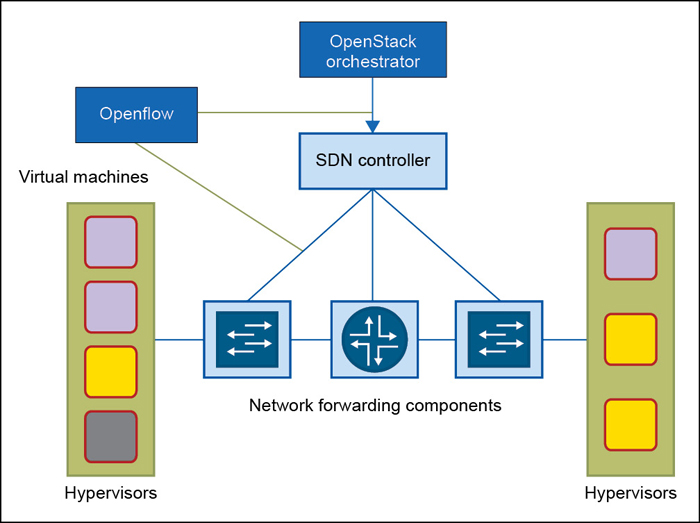
One of the important aspects of SDN is to keep different components in the network physically separate and yet make them work together in cohesion. For example, if we take a high-performance integrated-service gateway, it is likely to have a firewall, IDP/IDS, routing and switching system, all built into one box. When we take all these services to an SDN, we have different software components doing the firewall, IDP routing and switching. Also, in SDN only the forwarding of the actual connectivity has to be provided by a dedicated physical hardware. All these different components are controlled by a master component called the SDN controller.
This brings in a challenge to making sure that all these different components work together and are controllable by a controller in the network. This requires a protocol to be developed for the communication among the different components in an SDN network.
To understand the very-high-level architecture of the SDN network please see Fig. 3.
Open Network Foundation (ONF) (https://www.opennetworking.org) is a non-profit industry consortium that is leading the advancement of SDN and standardising critical elements of the SDN architecture, such as the OpenFlow protocol which structures communication between the control and data planes of supported network devices. OpenFlow is the first standard interface designed specifically for SDN, providing high-performance, granular traffic control across multiple vendors’ network devices.
Network management
One of the most important aspects of SDN is seamless network management. The SDN aims at delivering an application as a whole, rather than each network service. The high-level network applications are formed with well-orchestrated configuration of different network services. This demands an implementation of a very powerful and open network management system (NMS). An NMS which translates a high-level business policy into a configuration of each of the different service layers, including routing, switching, security and virtual machine provisioning, is the core of an SDN network. Along with providing easy configurability it should also provide a clear visibility in the network and highlight problems, if any.
Standards
ONF is the main organisation driving the standardisation effort of the SDN. It mainly deals with defining the protocols and standardising the way services should be provided in a network. The main idea is to keep the network components and services interoperable, so that healthy competition is maintained, and customers can choose the best components from different vendors.
Strengths of SDN
There is a complete transition of the network architecture in SDN. In SDN the control and data planes are decoupled, network intelligence and state are logically centralised and the underlying network infrastructure is abstracted from the applications. As a result, a network administrator gains unprecedented programmability, automation and network control, enabling him to build highly scalable, flexible networks that readily adapt to changing business needs.
OpenFlow-based SDN is currently being rolled out in a variety of networking devices and software, delivering substantial benefits to both enterprises and carriers, including:
1. Centralised management of networking equipment from multiple vendors
2. Improved automation so that network administrators deal just with the business policies and abstracting the underlying complication of provisioning individual components
3. Possibility of rapidly deploying newer services, without being blocked by any network device or a vendor to release an update
4. Opening avenues for all parities to generate revenue by enabling programmability of the network through open API, creating vendor independence
5. Centralised and automated management to increase the reliability of the network and, because the network is flexible, enhancing the reliability by automatically reprogramming in the event of failure
6. Granular network control with the ability to apply comprehensive and wide-ranging policies at the session, user, device and application levels
7. Enhance end users’ experience as the network adapts, the network is centralised and changes in the network appear seamless to the end-user
Conclusion
The strength of SDN lies in building a scalable and adaptable network which can be changed to adapt to the need of the environment. SDN banks on building the network with basic individual components, all separated out but controlled in unison using powerful software.
The SDN technology is still shaping up and different vendors are implementing the solution to differentiate themselves from the others, along with a strong standardisation effort being made by various organisations. It is difficult for each of these vendors to ignore the standardisation, but they are free to build in hooks such that their solutions work better with their own components than with a competitor’s components.
The main effect of the SDN will be seen by the service provider and the larger enterprises. The end users will experience the virtue of SDN in the form of enhanced services from the cloud, seamless usage of the network and security of their data.
The author has a masters degree in Communication and 14 years of work experience in telecommunications software. He is working at Juniper Networks, on their next generation network management solution










